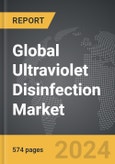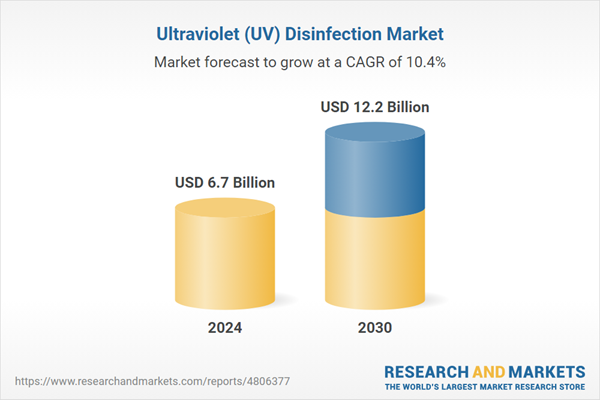The global market for Ultraviolet (UV) Disinfection was valued at US$6.7 Billion in 2024 and is projected to reach US$12.2 Billion by 2030, growing at a CAGR of 10.4% from 2024 to 2030. This comprehensive report provides an in-depth analysis of market trends, drivers, and forecasts, helping you make informed business decisions. The report includes the most recent global tariff developments and how they impact the Ultraviolet (UV) Disinfection market.
Technological advancements have significantly enhanced the efficiency and application scope of UV disinfection systems. Innovations such as high-output UV lamps, LED UV technology, and advanced reactor designs have improved the effectiveness and energy efficiency of these systems. High-output UV lamps emit more intense UV radiation, reducing the time required for disinfection and enabling the treatment of larger volumes of water or air. LED UV technology offers advantages such as lower energy consumption, longer lifespan, and the ability to produce specific wavelengths tailored to different disinfection needs. Moreover, sophisticated reactor designs optimize the exposure of microorganisms to UV light, ensuring consistent and thorough disinfection. These technological developments have expanded the applications of UV disinfection, making it suitable for more complex environments and enhancing its role in public health and safety.
The growth in the UV disinfection market is driven by several factors, including increasing concerns over water and air quality, the rise in healthcare-associated infections (HAIs), and the global demand for sustainable disinfection solutions. Heightened awareness of the health risks associated with contaminated water and air has led to greater adoption of UV disinfection technologies in municipal and industrial settings. The healthcare sector's focus on reducing HAIs has spurred the integration of UV disinfection systems in hospitals and clinics to sterilize surgical instruments, patient rooms, and air conditioning systems. Additionally, the push for sustainable and environmentally friendly disinfection methods has accelerated the shift towards UV technology, which does not rely on harmful chemicals or produce hazardous by-products. Government regulations and initiatives promoting clean water and air standards, coupled with advancements in UV technology, are further propelling the market. The increasing implementation of UV disinfection in residential settings, driven by consumer awareness and the availability of compact, affordable systems, also contributes to market growth, positioning UV disinfection as a key component in the future of public health and environmental safety.
Segments: Component (UV Lamps, Ballasts / Controller Units, Reactor Chambers, Quartz Sleeves, Other Components); Application (Water & Wastewater, Air, Other Applications); End-Use (Municipal, Residential, Commercial, Industrial).
Geographic Regions/Countries: World; USA; Canada; Japan; China; Europe; France; Germany; Italy; UK; Spain; Russia; Rest of Europe; Asia-Pacific; Australia; India; South Korea; Rest of Asia-Pacific; Latin America; Argentina; Brazil; Mexico; Rest of Latin America; Middle East; Iran; Israel; Saudi Arabia; UAE; Rest of Middle East; Africa.
The analysts continuously track trade developments worldwide, drawing insights from leading global economists and over 200 industry and policy institutions, including think tanks, trade organizations, and national economic advisory bodies. This intelligence is integrated into forecasting models to provide timely, data-driven analysis of emerging risks and opportunities.
Global Ultraviolet (UV) Disinfection Market - Key Trends & Drivers Summarized
Ultraviolet (UV) disinfection is a method that employs ultraviolet light to inactivate or destroy microorganisms, including bacteria, viruses, and protozoa. This technology is widely used for disinfecting water, air, and surfaces, providing an effective chemical-free solution for pathogen control. The mechanism behind UV disinfection involves exposing microorganisms to UV-C light, which penetrates their cell walls and disrupts their DNA, rendering them unable to reproduce and effectively neutralizing their threat. UV disinfection systems are implemented in various settings, from municipal water treatment plants and healthcare facilities to food processing industries and residential homes. The efficacy, rapid action, and environmental safety of UV disinfection make it a preferred choice for ensuring hygienic conditions across different domains.Technological advancements have significantly enhanced the efficiency and application scope of UV disinfection systems. Innovations such as high-output UV lamps, LED UV technology, and advanced reactor designs have improved the effectiveness and energy efficiency of these systems. High-output UV lamps emit more intense UV radiation, reducing the time required for disinfection and enabling the treatment of larger volumes of water or air. LED UV technology offers advantages such as lower energy consumption, longer lifespan, and the ability to produce specific wavelengths tailored to different disinfection needs. Moreover, sophisticated reactor designs optimize the exposure of microorganisms to UV light, ensuring consistent and thorough disinfection. These technological developments have expanded the applications of UV disinfection, making it suitable for more complex environments and enhancing its role in public health and safety.
The growth in the UV disinfection market is driven by several factors, including increasing concerns over water and air quality, the rise in healthcare-associated infections (HAIs), and the global demand for sustainable disinfection solutions. Heightened awareness of the health risks associated with contaminated water and air has led to greater adoption of UV disinfection technologies in municipal and industrial settings. The healthcare sector's focus on reducing HAIs has spurred the integration of UV disinfection systems in hospitals and clinics to sterilize surgical instruments, patient rooms, and air conditioning systems. Additionally, the push for sustainable and environmentally friendly disinfection methods has accelerated the shift towards UV technology, which does not rely on harmful chemicals or produce hazardous by-products. Government regulations and initiatives promoting clean water and air standards, coupled with advancements in UV technology, are further propelling the market. The increasing implementation of UV disinfection in residential settings, driven by consumer awareness and the availability of compact, affordable systems, also contributes to market growth, positioning UV disinfection as a key component in the future of public health and environmental safety.
Report Scope
The report analyzes the Ultraviolet (UV) Disinfection market, presented in terms of units. The analysis covers the key segments and geographic regions outlined below.Segments: Component (UV Lamps, Ballasts / Controller Units, Reactor Chambers, Quartz Sleeves, Other Components); Application (Water & Wastewater, Air, Other Applications); End-Use (Municipal, Residential, Commercial, Industrial).
Geographic Regions/Countries: World; USA; Canada; Japan; China; Europe; France; Germany; Italy; UK; Spain; Russia; Rest of Europe; Asia-Pacific; Australia; India; South Korea; Rest of Asia-Pacific; Latin America; Argentina; Brazil; Mexico; Rest of Latin America; Middle East; Iran; Israel; Saudi Arabia; UAE; Rest of Middle East; Africa.
Key Insights:
- Market Growth: Understand the significant growth trajectory of the Water & Wastewater segment, which is expected to reach US$9.1 Billion by 2030 with a CAGR of a 10.7%. The Air segment is also set to grow at 9.9% CAGR over the analysis period.
- Regional Analysis: Gain insights into the U.S. market, valued at $1.6 Billion in 2024, and China, forecasted to grow at an impressive 12.5% CAGR to reach $2.4 Billion by 2030. Discover growth trends in other key regions, including Japan, Canada, Germany, and the Asia-Pacific.
Why You Should Buy This Report:
- Detailed Market Analysis: Access a thorough analysis of the Global Ultraviolet (UV) Disinfection Market, covering all major geographic regions and market segments.
- Competitive Insights: Get an overview of the competitive landscape, including the market presence of major players across different geographies.
- Future Trends and Drivers: Understand the key trends and drivers shaping the future of the Global Ultraviolet (UV) Disinfection Market.
- Actionable Insights: Benefit from actionable insights that can help you identify new revenue opportunities and make strategic business decisions.
Key Questions Answered:
- How is the Global Ultraviolet (UV) Disinfection Market expected to evolve by 2030?
- What are the main drivers and restraints affecting the market?
- Which market segments will grow the most over the forecast period?
- How will market shares for different regions and segments change by 2030?
- Who are the leading players in the market, and what are their prospects?
Report Features:
- Comprehensive Market Data: Independent analysis of annual sales and market forecasts in US$ Million from 2024 to 2030.
- In-Depth Regional Analysis: Detailed insights into key markets, including the U.S., China, Japan, Canada, Europe, Asia-Pacific, Latin America, Middle East, and Africa.
- Company Profiles: Coverage of players such as Advanced UV, Inc., American Ultraviolet Company, Atlantic Ultraviolet Corporation, Atlantium Technologies Ltd., Calgon Carbon Corporation and more.
- Complimentary Updates: Receive free report updates for one year to keep you informed of the latest market developments.
Some of the 115 companies featured in this Ultraviolet (UV) Disinfection market report include:
- Advanced UV, Inc.
- American Ultraviolet Company
- Atlantic Ultraviolet Corporation
- Atlantium Technologies Ltd.
- Calgon Carbon Corporation
- Evoqua Water Technologies LLC
- Hitech Ultraviolet Pvt. Ltd.
- Trojan Technologies Group ULC.
- UV Pure Technologies
- UV Technology Ltd
- UV-Technik Speziallampen GmbH
- Xylem
Tariff Impact Analysis: Key Insights for 2025
Global tariff negotiations across 180+ countries are reshaping supply chains, costs, and competitiveness. This report reflects the latest developments as of April 2025 and incorporates forward-looking insights into the market outlook.The analysts continuously track trade developments worldwide, drawing insights from leading global economists and over 200 industry and policy institutions, including think tanks, trade organizations, and national economic advisory bodies. This intelligence is integrated into forecasting models to provide timely, data-driven analysis of emerging risks and opportunities.
What’s Included in This Edition:
- Tariff-adjusted market forecasts by region and segment
- Analysis of cost and supply chain implications by sourcing and trade exposure
- Strategic insights into geographic shifts
Buyers receive a free July 2025 update with:
- Finalized tariff impacts and new trade agreement effects
- Updated projections reflecting global sourcing and cost shifts
- Expanded country-specific coverage across the industry
Table of Contents
I. METHODOLOGYMII. EXECUTIVE SUMMARY2. FOCUS ON SELECT PLAYERSIII. MARKET ANALYSISCANADAJAPANCHINAFRANCEGERMANYITALYUNITED KINGDOMSPAINRUSSIAREST OF EUROPEASIA-PACIFICAUSTRALIAINDIASOUTH KOREAREST OF ASIA-PACIFICLATIN AMERICAARGENTINABRAZILMEXICOREST OF LATIN AMERICAMIDDLE EASTAFRICAIV. COMPETITION
1. MARKET OVERVIEW
3. MARKET TRENDS & DRIVERS
4. GLOBAL MARKET PERSPECTIVE
UNITED STATES
EUROPE
Companies Mentioned (Partial List)
A selection of companies mentioned in this report includes, but is not limited to:
- Advanced UV, Inc.
- American Ultraviolet Company
- Atlantic Ultraviolet Corporation
- Atlantium Technologies Ltd.
- Calgon Carbon Corporation
- Evoqua Water Technologies LLC
- Hitech Ultraviolet Pvt. Ltd.
- Trojan Technologies Group ULC.
- UV Pure Technologies
- UV Technology Ltd
- UV-Technik Speziallampen GmbH
- Xylem
Table Information
| Report Attribute | Details |
|---|---|
| No. of Pages | 574 |
| Published | April 2025 |
| Forecast Period | 2024 - 2030 |
| Estimated Market Value ( USD | $ 6.7 Billion |
| Forecasted Market Value ( USD | $ 12.2 Billion |
| Compound Annual Growth Rate | 10.4% |
| Regions Covered | Global |









